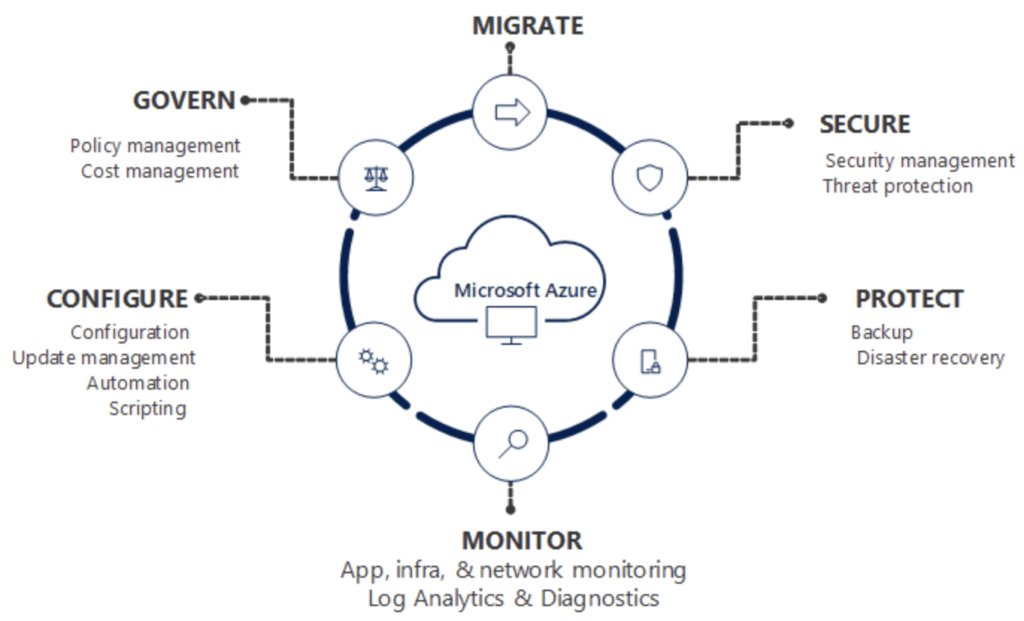What Is Cloud Management Software?
The modern innovations in online technology allow you to work from anywhere because you can access your projects from the cloud. Most organizations today use cloud resources to some degree. In 2019, Flexera found 91% of companies were using public cloud options, 72% used private clouds. 28% of the cloud users also noted hybrid cloud options as a priority.
The increased use of cloud applications makes cloud management platforms (CMP) a priority for large data entries or teams that work with incredible amounts of data. Some aspects of cloud management platforms may be of use to smaller organizations as well, like protection or cost management.
In the next section, we’ll go into more detail on what cloud management software is, and why they’re useful.
What Is Cloud Management Software?
Cloud management software seems simple–-it’s software created to manage your cloud-based resources. The complicated part is the functionality of cloud management tools. Cloud management software has many different use cases, and it’s evolved quite a bit to meet changing needs.
Cloud management used to be more about just cost and flexibility, but many new platforms also promise analysis, and powerful AI’s. This video goes into the evolution of cloud management based on what they offered consumers.
On top of different needs, there are 3 different types of cloud computing services: infrastructure as a service (IaaS), software as a service (SaaS), and platform as a service (PaaS). They are also classified by whether they are public or private, with 4 types: public cloud, private cloud, hybrid cloud, and multi-cloud.
This is partly why cloud management software varies in what they do. Each cloud service is different and could be used for several important functions. So the type of cloud management software you use depends on your project, and which cloud service you use. Many sources will also define what cloud management software does differently because there are so many points to focus on.
Many of the public cloud giants, Microsoft Azure, Amazon Web Services, and Google Cloud, offer services within their clouds for the management of your resources. These cloud platforms offer cloud management applications to help you monitor your usage, automation, applications, functions, and projects.
The cloud management software these big platforms offer tends to be very important for tracking usage and in turn, your spending. Unfortunately, there isn’t one service that manages all your resources, but rather a number of split-up services that cloud management services would offer.
Microsoft Azure is a great example because they divide the jobs of management between Migrate, Govern, Configure, Monitor, Protect, and Secure. Under Configure is Azure Automation which is used for orchestration, deployment, management, and automation of tasks. Those options alone are pretty important cloud management tools.

AWS on the other hand is a little less scattered and offers CloudWatch as an option for staying on top of your cloud applications. Google Cloud is more like Microsoft and has a number of cloud management tools.
A term that will pop up when learning about cloud management software is Kubernetes. Now, unlike the paid juggernaut cloud platforms above, Kubernetes is an open-source container as a service (CaaS) that can allow you to run all 4 kinds of cloud services (public, private, hybrid, multi-cloud). Kubernetes can let you host and run containerized applications of cloud environments.
You can manage cloud environments with Kubernetes’ own capabilities for self-healing, automation, and orchestration. Depending on the service though, you may need to use other open-source services. For more about how Kubernetes works, you can see Red Hat’s definition. Red Hat is one of the main contributors of the Kubernetes project, even before Google launched it.
Even though Kubernetes has its own cloud management functions, many still use it on cloud giants like AWS and Microsoft. This is because with managed services you can do more with Kubernetes. There are serveral management services just with Kubernetes in mind. You could choose cloud giants to run Kubernetes, or you could look at managed Kubernetes services.
Below, we’re going to speed through the very long list of the different cloud management services and features you can find.
Cloud Management Software Capabilities
Cloud Management Software can manage broad specs of your cloud resources and incredibly minuscule parts. They generally vary over a number of components that provide coverage for the data or the applications. These are security/disaster recovery, cost, performance, governance, orchestration, and monitoring/tracking.
Cloud security is a big benefit some cloud providers already have but can be an added defense in a cloud management tool. Cloud cost optimization is a major feature of cloud management, especially for pay as you go cloud services. Governance would be rules of policies in place or the hierarchy of admin control over your resources. Orchestration can be the process of task automation, and management.
Performance and monitoring are especially important for cloud computing. They can be helpful for working on virtual machines, developing apps, or APIs. The ability to follow the overall performance and chronological tracking mean finding bugs faster, being able to meet goals accurately, and so much more.
Cloud Software Examples
There are several examples of popular cloud management software you might consider for your business needs. These include Oracle Enterprise Manager, VMware’s vRealize, Rubrik, Datadog, and CloudStack. This software is great for small and larger enterprises. Many of which are connected to clouds with other valuable applications.
Enterprise Manager is a cloud management service for Oracle products. You can use it on-premises for the automation and management of Oracle apps.
VMware is a multi-cloud environment that offers the cloud management product vRealize. vRealize is designed for great hybrid and multi-cloud management. You can use them both on-premise and as a SaaS product.
Rubrik is another popular cloud management software that actually works with vRealize for API automation. They can migrate, track, and modernize your data, all with data protection in mind. This makes Rubrik a good choice for those with security at the top of their cloud needs.
A powerful cloud management option that isn’t limited to management is Datadog. Datadog is an application performance management APM SaaS option for large enterprises that want to access its infrastructure monitoring capabilities.
Then there’s the Apache giant’s service CloudStack. CloudStack is an open-source IaaS option for resource management. You can use it on-premises as a private cloud or through another service like VMware.
More Resources
There is so much more to understand and learn about cloud management and cloud management software. For those that want to learn more, we have some great places to look. If you want a very intricate cloud management definition you could check out this article here.
Red Hat is another great resource to learn more, they are an IBM-owned company that prioritizes knowledge about open source products. Those of you that want to look at other cloud management and their reviews, see our list of software.
If you’ve used some of the software in the article, please consider leaving a review to help other buyers make informed decisions.
Was this helpful?

Looking for your next cloud management software? Start by reading 100% authentic reviews from users just like you.
